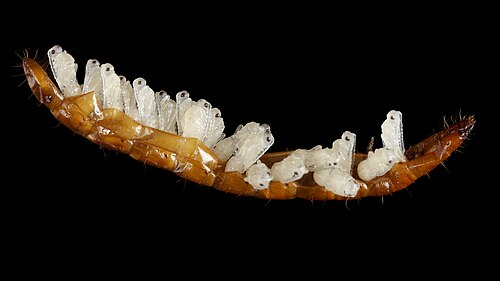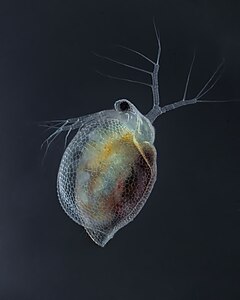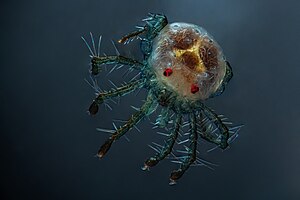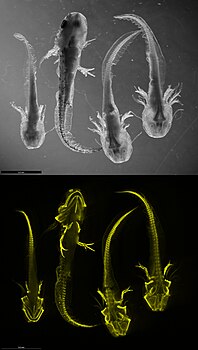Commons:Wiki Science Competition 2023/Winners/Estonia
Jump to navigation
Jump to search
Argentina · Estonia · Finland · France and Monaco · Indonesia · Ireland · Italy · Malaysia · Nigeria · North Macedonia · Poland · Russia · South Africa · Spain · Switzerland · Ukraine · United States ··· The rest of the World
People in Science · Microscopy images · Non-photographic media · Wildlife & nature · Astronomy · General category · Image sets ··· Winners
![]() These are the finalists for WSC2023 in Estonia.
These are the finalists for WSC2023 in Estonia.
This country-level selection had a specific national organizer and a national coordination page. 81 files were submitted by 19 uploaders.
Jury
[edit]- the selection was performed manually.
- coordinator: Kruusamägi.
- the jurors were: Jaak Kikas, Ivo Kruusamägi, Ulvar Käärt, Jaan-Juhan Oidermaa, Monika Reppo, Urmas Tartes.
National winners
[edit]| Microscopy images from Estonia | ||||
National winner |
||||
| Pupae of the Paracodrus apterogynus in the shell remains of a click beetle (Elateridae) larva. The parasitized wireworm was collected in Estonia on August 27, 2021. Enno Merivee |
| |||
Finalist |
Finalist | Finalist | ||
| Recently, it was discovered that various insects with seemingly transparent wings, display vivid structural coloration against dark backgrounds. Wing interference patterns in the banded mosquito Culiseta annulata. Enno Merivee | Microscope image of colloid particles. Artificial opal made by drying a monodisperse sub-micrometer polystyrene sphere solution under a optical darkfield microscope. Siim Pikker | Silver micromirrors imaged with backscattered electrons in an electron microscope. Field of view 105 μm and imaging voltage 30 kV. These crystalline micromirrors are important model systems for micro and nanooptics research. Siim Pikker
| ||
| Finalist | Finalist | Finalist | ||
| Chaoboridae larvae. Janek Lass | Oxidized surface of copper seen under a microscope. Sheet of copper was corroded, the bluish compound is copper(II) carbonate hydroxide. Tavo Romann | A vanadium crystal partially covered with purple (probably vanadium(IV) oxide) and green (some trivalent vanadium salts) corrosion products. Tavo Romann
| ||
| People in Science images from Estonia | ||||
National winner |
||||
| core sampling in a bog in Estonia. Peeter Paaver |
| |||
Finalist |
Finalist | Finalist | ||
| Lecture about the largest rocks in Estonia on the northern coast in Tammispea. Peeter Paaver | Dr David T. Jones from Natural History Museum of London giving a practical tutorial about measuring average earthworm count per hectare, thus helping Estonian farmers get an indication about their soil's health. Märt Kose | Patrick Teppor and PEM active layer deposition by ultrasonic spraying. Tavo Romann
| ||
| Non-photographic media from Estonia | ||||
National winner |
||||
| This video shows the property of carbon dioxide to go into a supercritical state with increasing temperature. Initially, a small amount of carbon dioxide was soldered in a small glass ampoule at a pressure of about 70 atmospheres. When the ampoule was heated, the carbon dioxide inside began to pass into a supercritical state, thereby creating an unusual state of matter, not liquid and not gas. After cooling, the opposite effect can be observed, quite spectacular. Maxim Bilovitskiy |
| |||
Finalist |
Finalist |
Finalist | ||
| Video of silver micromirrors in solution under optical darkfield microscope demonstrating Brownian motion, Casimir effect and colorful scattering of surface plasmons. Diameter of silver micromirrors range from around 2-20 μm. Thickness of the crystalline mirrors is between 100-200 nm. Siim Pikker | Sublimation of iodine under a microscope. The freshly prepared iodine crystals were placed under a microscope, where they started sublimating (i.e. evaporate without becoming liquid) under the influence of the heat of the microscope light. 20x microscope objective was used and bright field contrast. Tavo Romann | Melting an iron nail with a supercapacitor. A 3000 F supercapacitor was short-circuited through an iron nail. A current of 1000 amperes caused the iron nail to melt. Tavo Romann
| ||
| Finalist | Finalist | |||
| Making stainless steel from iron ore by aluminothermy. To better separate the resulting metal from the slag, cryolite and calcium fluoride were added to the mixture. Maxim Bilovitskiy | Slow-motion video of a singing male katydid Conocephalus fuscus. Veljo Runnel |
| ||
| Wildlife & nature images from Estonia | ||||
National winner |
||||
| Kostivere Karst field in Ordovician limestone. Peeter Paaver |
| |||
| Finalist | Finalist | Finalist | ||
| Travertine terraces in Pamukkale, Turkey. For many thousands of years, water saturated with minerals has left behind a precipitate of calcium salts, mainly from calcium carbonate, thereby forming unusual stepped geological forms. Recently, due to climate change, precipitation in this region has decreased, which caused many travertines to dry up. Maxim Bilovitskiy | Common Blue Damselflies in heart-shaped mating position. The blue male clings the neck of his brown female partner while she curls her abdomen so that their gonads can touch. Photographed in Estonia, Põlva county. Tavo Romann | Outskirts of Longyeabyan (Svalbard) with first snow and low tide. Peeter Paaver
| ||
| Astronomy images from Estonia | ||||
National winner |
||||
| Photo of ionized gas region IC 1396 located in the constellation Cepheus about 2,400 light years away from Earth. The entire region is ionized by the massive star nearby (HD 206267), except for dense globules that can protect themselves from the star's ultraviolet rays. The combined action of the light from the massive star ionizing and compressing the rim of the cloud, and the wind from the young stars shifting gas from the center outward lead to very high compression in the Elephant's Trunk Nebula. This pressure has triggered the current generation of protostars. Taavi Niittee |
| |||
| Finalist | Finalist | Finalist | ||
| The Soul Nebula (above) and The Heart Nebula (below) in the constellation Cassiopeia. Taavi Niittee | Andromeda galaxy (M31) in constellation Andromeda. Taavi Niittee | Northern lights in Maardu, Estonia. Maxim Bilovitskiy
| ||
| General category images from Estonia | ||||
National winner |
||||
| Erratic rocks around a peninsula in Northern Estonia. Peeter Paaver |
| |||
| Finalist | Finalist | Finalist | ||
| Synthetic diamonds, which had a different shade due to the different content of nitrogen impurities. Maxim Bilovitskiy | A single crystal of a Mn(II) complex, [BnMIm]4[MnBr4]Br2. Its bright green color originates from spin-forbidden d-d transitions. Verner Sääsk | Fluorescence of (9H-carbazol-9-yl)(2,4-dichlorophenyl)methanone. Verner Sääsk
| ||
| Finalist | Finalist | |||
| Air is a poor conductor of electricity, but with sufficient voltage (30 kV/cm), air transforms into a conductor, resulting in a spark discharge. AHHAA | TV from 1963. Maxim Bilovitskiy |
| ||
| Image sets from Estonia
| ||||
|
| ||||
-

Finalist. Analysis of collagen expression in young salamanders via HCR FISH visualization. Lennart Rikk
Finalist. Investigating the composition of iron. Kristo Oks
Finalist. Reference collection work for archaeological dental calculus. Agnes Unt






































